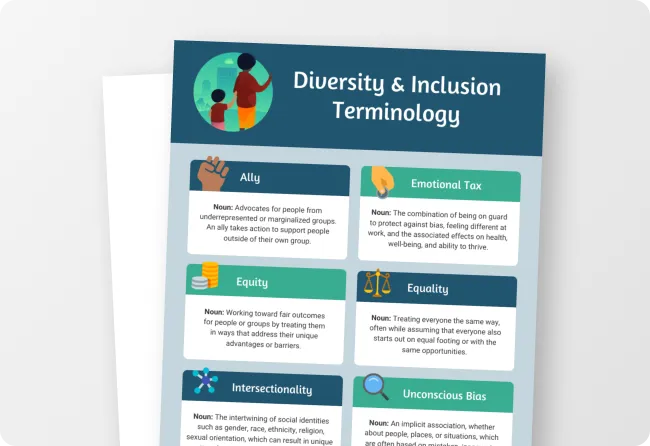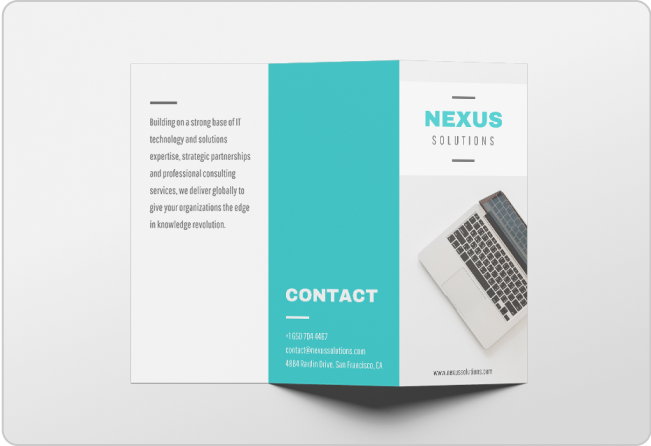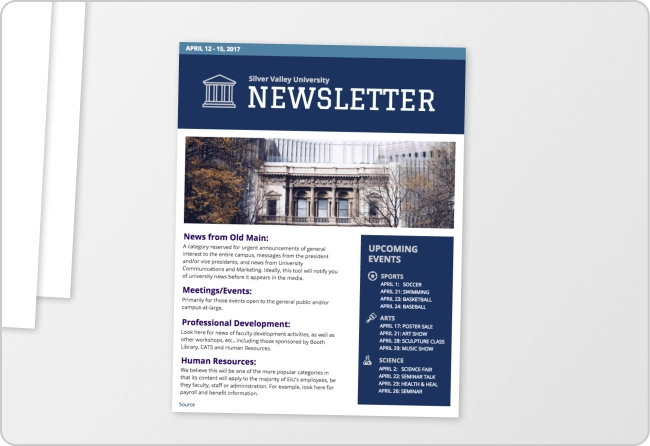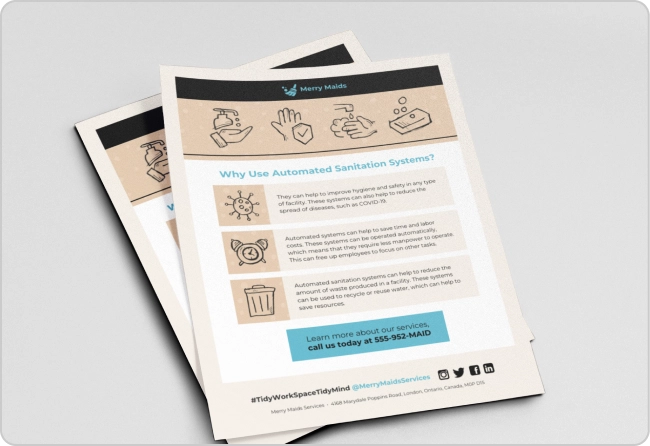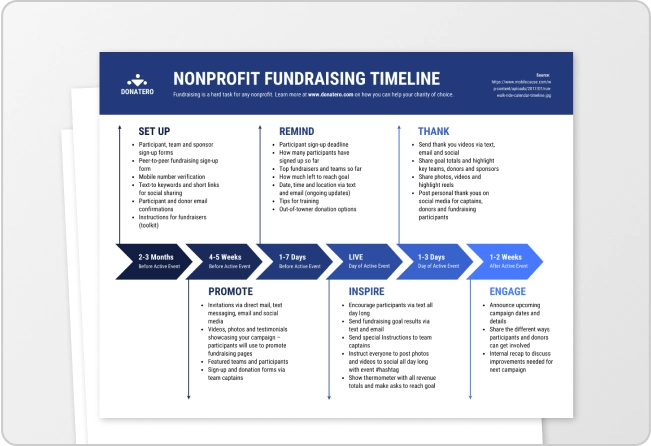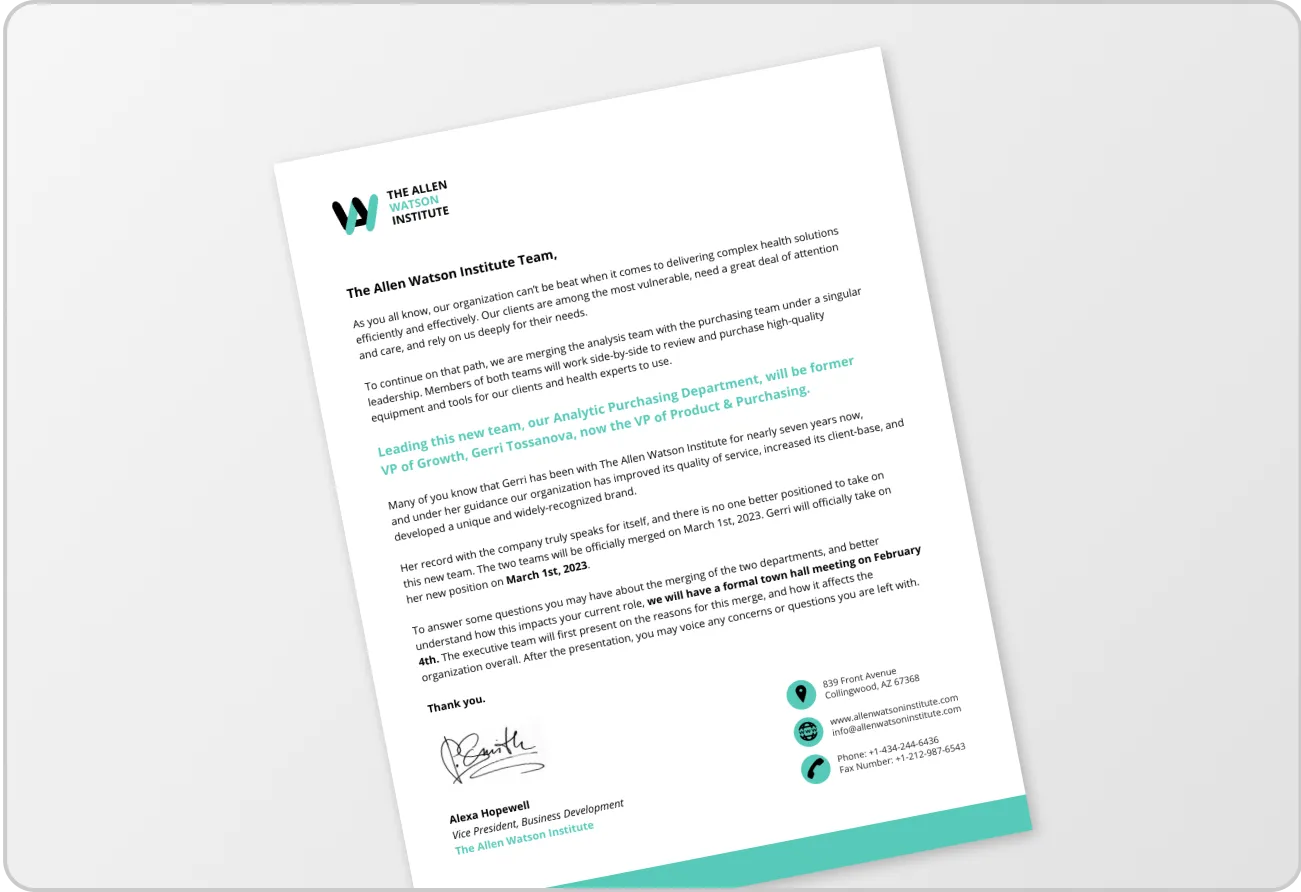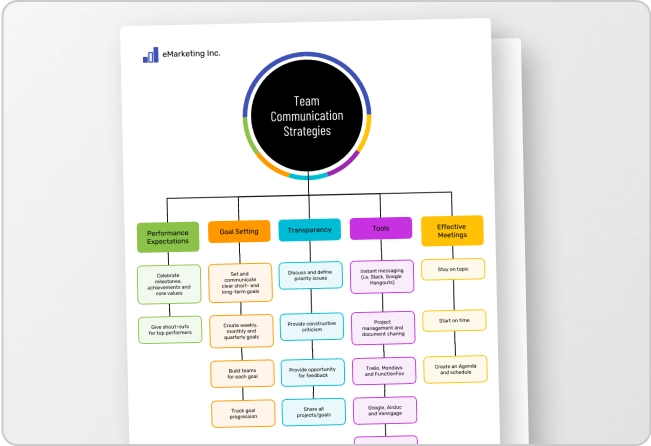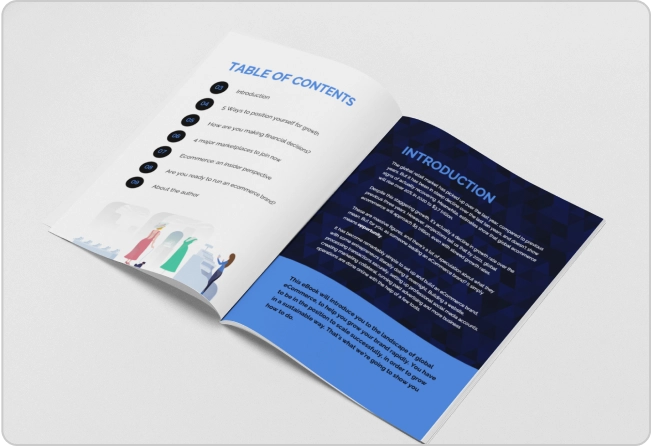
Lesson plans are the best way to deliver an effective and engaging lesson. Lesson plans also help keep you on track to ensure that your learners hit their goals and targets, in line with your course curriculum.
But sometimes in the high-pressure world of education, it can be difficult to find the time to create inspiring lesson plans on your own. This is the time to enlist the help of a lesson plan maker and lesson plan templates.
I’ve gathered together some of the best lesson plan examples for all grade levels that you can use to ensure your lessons are insightful and inspiring.
1. English lesson plan example
An English lesson plan helps organize learning objectives, activities, and assessments for a structured and effective lesson.
This noun lesson plan example demonstrates how to teach Common and Proper Nouns using flashcards, interactive discussions and hands-on classification activities. With a well-structured approach, you can create engaging online English lessons that enhance student understanding and participation.
2. History lesson plan example
Creating a history lesson plan is essential for a successful session no matter if you’re teaching the near past or the ancient history.
Using common teaching resources such as timeline infographics, or imaginative play and learning are exciting ways to make your History lesson plans exciting.
Prepare for history lessons with a history timeline infographic
Engaging history lessons rely on a teacher’s ability to bring the past to life and simplify complex events. Since some students struggle with mentally visualizing history, a timeline infographic is a powerful tool for illustrating key events clearly.
For a well-structured history lesson plan, organize your timelines in advance or have students create their own as an interactive activity. Venngage offers customizable timeline infographic templates to enhance student engagement and make learning history more visual and effective.

Use themes and historical events to enrich your lesson planning
When planning your history lessons, look for topical themes or historical events that you can anchor your lesson plan around.
In the lesson plan example below, the teacher is using Black History Month as an anchor point for their students’ learning.

Teaching the historical significance of Black History Month and engaging students in related learning activities throughout February is a great way to contextualize current affairs. There are plenty of resources online to help create your Black History Month lesson plans.
3. Middle school lesson plan example
Middle school is a key stage where students develop lifelong skills. A strong lesson plan template includes clear objectives, structured activities and assessments to ensure students not only find the right answers but also understand the learning process.
If students are struggling with writing assignments, paper writer services can be an excellent resource to help them refine their writing skills and meet academic standards.
Check out the middle school lesson plan example below—it features a dedicated section for defining success, helping both teachers and students stay on track for meaningful learning outcomes.

Related Reading: What Disney Villains Can Tell Us About Color Psychology
4. Kindergarten lesson plan example
A well-structured kindergarten lesson plan builds on preschool principles while introducing more focus on foundational academic skills. Staying organized is key, and having a clear, easy-to-follow plan helps keep lessons engaging and on track.
Use themes to help plan your Kindergarten lessons
Thematic learning helps young children stay engaged by connecting different subjects under one common idea. This kindergarten lesson plan example uses St. Patrick’s Day as a theme, integrating Math, Art, and Science activities to create a fun and cohesive learning experience.
Check out the kindergarten lesson plan template below for inspiration
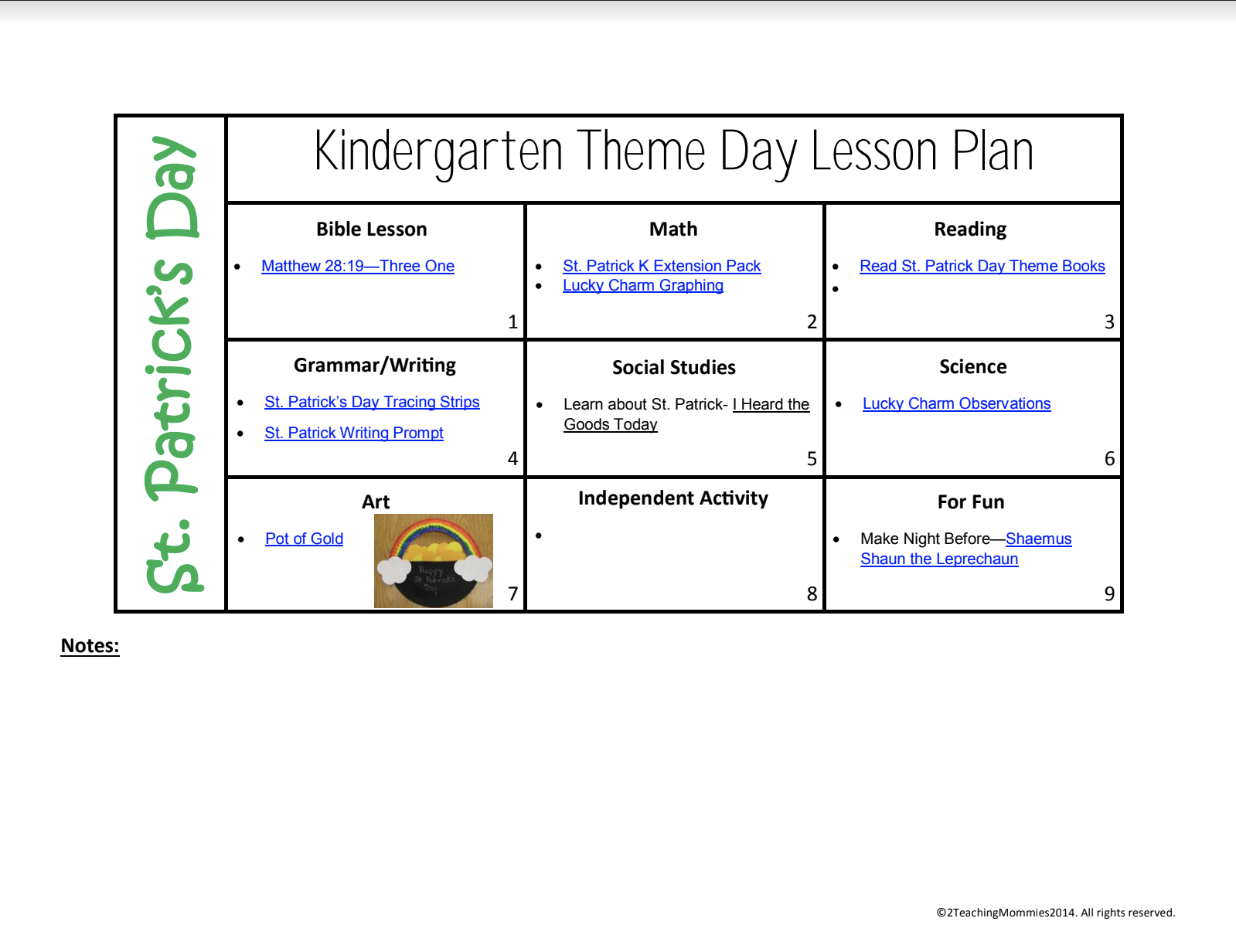
5. High school lesson plan example
Creating a high school lesson plan involves a more structured approach, as students at this level are typically engaged in more advanced academic subjects.
Ensuring that your High School lesson plans account for success and reinforcing skills is one way to deliver the best education for your learners.
Include indicators of skill in your high school lesson plans
The high school lesson plan example below includes skill indicators to help measure student understanding and guide instruction. Adding two to three indicators allows teachers to track progress and identify students needing extra support. For example, a math tutoring session can assess problem-solving skills, helping plan targeted interventions for struggling learners.

Skill indicators aside, adapting a timeline template like the one below one helps students clearly understand important dates for their school projects. It provides structure, improves organization and makes learning more engaging.

6. Preschool lesson plan example
Designing a preschool lesson plan requires balancing essential developmental skills while keeping lessons engaging. With so much to cover, a structured plan helps ensure steady progress.
Break your preschool lesson plans into learning sections
Preschool curriculums cover multiple areas of early childhood development. Breaking your preschool lesson plan into focused sections, like in this example, makes it easier to track progress and ensure each skill gets the attention it needs.
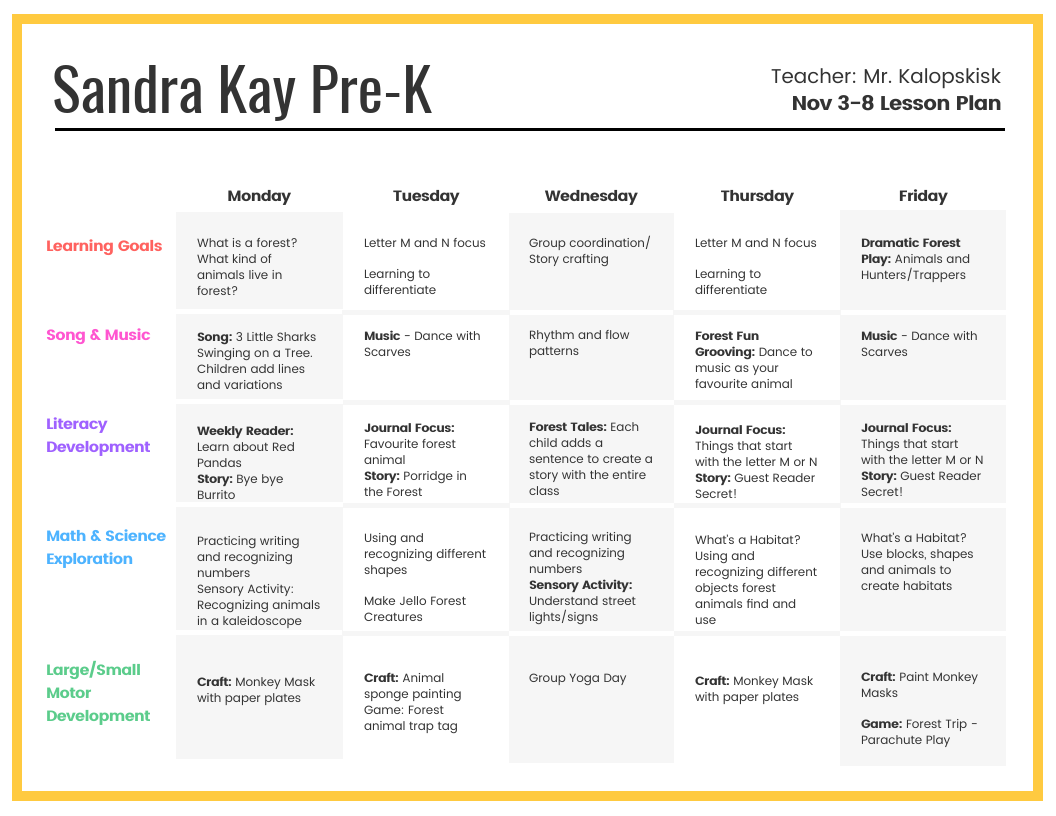
7. Math lesson plan examples
A well-structured math lesson plan keeps instruction clear and students engaged. This math lesson plan example provides inspiration to simplify your planning process.
In this example, mint green sections enhance readability. Using color-coding for different math topics or units improves organization, highlights key concepts, and helps students retain important information more effectively.
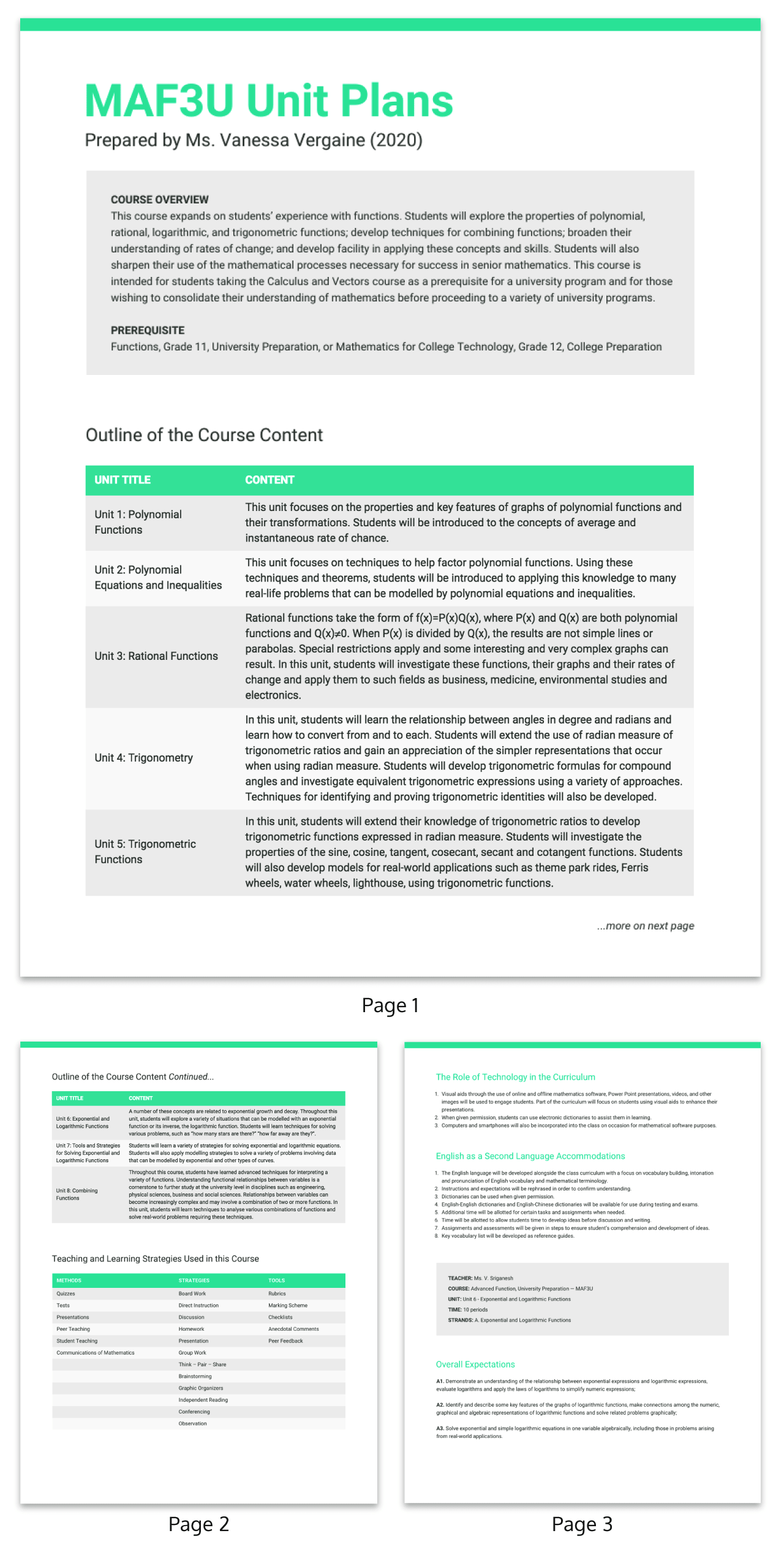
If you want to learn how to write an actional learning objective, check out this post on learning objective examples.
8. Elementary lesson plan example
Elementary students study various subjects simultaneously, making it essential to keep track of each one. A weekly lesson plan helps maintain structure and ensures students stay on track.
This elementary lesson plan template breaks subjects and activities into daily sections with simple summaries, making lesson planning more efficient and effective.
9. Art lesson plan example
When creating art lesson plans, use bright colors, patterns, icons and graphics to create a truly engaging visual art lesson plan, like in the examples below.
Art lessons lend themselves to creative and visual learning, so your Art lesson plans should be creative and visual as well.
Incorporate learning examples in your art lesson plans
When designing an art lesson plan, incorporate bright colors, patterns, icons, and graphics to make it visually engaging—just like in the example below.
Art is a creative and visual subject, so your lesson plan should reflect that creativity. In this art lesson plan example, the teacher includes visual examples directly in the plan, making it easy to reference during the lesson. Keeping all materials in one place ensures a smooth and engaging teaching experience.

10. Science lesson plan example
Planning a science lesson can involve experiments, observations, diagramming, and labeling. Using a science lesson plan template, like the example below, helps keep lessons organized and running smoothly.
Provide a space for reflection in your science lesson plan
A science lesson plan isn’t just for scheduling activities—it’s also a valuable tool for improvement. Adding a reflection section like in the example below lets you note what worked well and what needs adjustment, making future lessons more effective.

Break projects down into sections of deliverables
For hands-on science projects, breaking tasks into clear deliverables ensures students understand expectations. A checklist can help keep projects structured, improving organization and engagement.
This science lesson plan example includes a structured breakdown of tasks, making it easier to manage complex lessons and track student progress.

11. Simple lesson plan example
A simple lesson plan breaks content into manageable sections and incorporates straightforward activities, making teaching more efficient.
When you’re mid-lesson and need a quick reference, a clear and concise lesson plan is invaluable. A clean, modern design helps you stay focused on what matters most—teaching.
A simple lesson plan doesn’t have to be dull. Incorporating good design principles and following one or two graphic design trends keeps it professional and easy to navigate.
This simple lesson plan example uses a structured layout that ensures clarity while maintaining a polished look, making lesson planning stress-free.

12. eLearning lesson plan example
When creating eLearning, distance learning, remote learning, digital learning lesson plans—basically, anything outside the usual classroom setup—always be ready for its own set of unique challenges.
Engaging learners from behind a screen, or creating lessons that can exist outside of a traditional classroom environment can be difficult. But proper eLearning lesson plans can help you navigate non-traditional learning environments.
Break your eLearning lesson plan into activities or subjects
With so many people shifting to remote or digital learning keeping track of all of your separate subjects can be difficult. Creating an eLearning lesson plan that is broken into smaller chunks, with space for each topic, is an easy way to keep learning on track.
In this eLearning lesson plan example subjects are color coded and broken into small blocks.

For more examples of eLearning lesson plans, check out this post on course design templates.
How to create a lesson plan
A good lesson plan doesn’t just fill time, it guides students toward clear learning goals. Here’s a simple way to build one that’s practical and effective:
Start with the goal: Begin by defining what you want students to learn. Keep your objectives specific and measurable so you can easily track progress later.
Know your students: Think about who you’re teaching. What are their backgrounds, learning styles or challenges? Understanding your students helps you plan lessons that actually connect with them.
Choose the right approach: Pick teaching methods that make sense for your goals, maybe that’s hands-on activities, group discussions or quick demonstrations. The best approach is one that keeps students engaged and learning actively.
Plan the flow: Map out how the lesson will run from start to finish. Break it into stages like introduction, main activity, practice and wrap-up and estimate how long each part should take. Smooth transitions help keep things on track.
Align activities and assessments: Make sure your exercises and assessments link back to your goals. For instance, if your objective is to build teamwork, include group tasks and reflect on collaboration afterward.
Reflect and refine: After the lesson, take a few minutes to think about what went well and what could be improved. A little reflection helps every lesson get better over time.
For a full walkthrough (with examples and templates), check out this guide on how to write a lesson plan.
Conclusion
Writing a lesson plan from scratch can be difficult, which is why Venngage has created tons of lesson plan templates you can edit easily. You can also draw inspiration from the different lesson plan examples in this post to customize your lesson plan template.
Simply create a Venngage account, pick the template you want and begin editing. It’s free to get started.






























